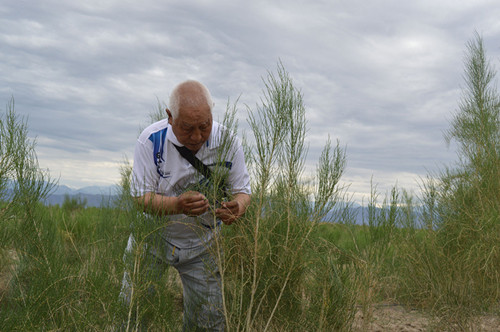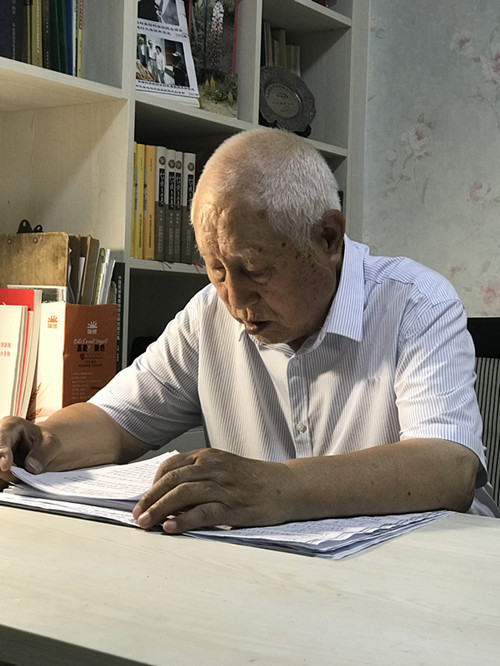Red willow whizs work pays dividends in desert
2019-07-22

Liu Mingting examines his red willow sapling. [Photo provided to China Daily]
[CHINA DAILY] Deep within the Taklimakan Desert, known by locals as the "Sea of Death", grows a unique type of shrub with reddish stems, small pink flowers and feathery, pale green foliage. Legend says the plant germinated from the blood of a young warrior who ventured into the desert to slay the drought demon.
When a sandstorm hits, the shrub's stems swing gracefully in the harrowing wind, decorating China's largest desert-337,000 square kilometers in area located in the Xinjiang Uygur autonomous region-with much-needed color and life.
The plant, commonly known as red willow or hongliu (Tamarix taklamakanensis), is more than a testimony to life's tenacity. It serves as the first line of defense, protecting other parts of China from the desert's sandstorms by fixing large patches of sand with its expansive root network.
While other types of red willow can be found in Central Asia and the Middle East, the discovery of the unique Chinese species by scientists six decades ago marked a milestone in China's desert control effort and brought new economic opportunities to the local Uygur population.
Liu Mingting, a world-renowned expert in desert control and a researcher at the Chinese Academy of Sciences' Xinjiang Institute of Ecology and Geography, said he still remembers the day when he first stumbled upon the plant decades ago.
In mid-July, the Publicity Department of the Communist Party of China Central Committee named the 86-year-old scientist as one of the "most admirable people to support the borderlands", a title given to 20 luminaries who have made profound and lasting contribution to China's western borders.
In 1956, Liu, a senior biology student at Lanzhou University in Gansu province, was interning at a field station in southern Xinjiang. There he saw a common red willow "battling fearlessly against the wind, sand, and salinity of the vast and unforgiving desert".
"This moved me tremendously," he recalled.

Liu Mingting, a world-renowned expert in desert control and a researcher at the Chinese Academy of Sciences' Xinjiang Institute of Ecology and Geography. [Photo provided to China Daily]
Just before graduation, Liu wrote to Yang Xiufeng, then minister of higher education. He asked Yang to "send me to the most desolate place in China. Send me to the borderlands."
Liu got his wish and was later transferred to the Xinjiang institute with his family, where he spent decades finding and breeding the ideal red willow species to serve as cheap and effective sandstorm buffers.
"Desert control is a very tough job. The work environment is very desolate and the weather is hot, so not many people wanted to go with me," Liu said. "But I made a promise to myself. I came to Xinjiang because I wanted to ameliorate the barren environment."
During an expedition into the Taklimakan Desert in 1959, Liu finally found the right red willow species he was looking for. Discovering the right species was just the first step; the next was to mass cultivate and plant them around the desert border, creating "an artificial green buffer zone", Liu said.
He later discovered four more species, becoming one of the world's leading experts in tackling desertification. He was revered by peers from the United Nations Environment Programme as "Liu Hongliu".
Liu then spent the next two decades researching red willows in the desert, increasing the per hectare yield from 750,000 shrubs to 7.5 million. During this period, Qira and Keriya counties near the desert's edge were constantly battered by sandstorms, which devastated crops and impoverished residents, driving them from their homes. Lyrics in a local folk ballad even mention "eating sand and dirt day in and day out".
In 1982, an emergency report reached the autonomous region's government detailing how shifting sands were just 1.5 km from Qira. The local government immediately launched a massive desert control project to save the county.
Liu and his team were tasked with fixing 4,000 hectares of shifting sand within five years. The red willows he discovered played a significant role as the centerpiece of his geoengineering efforts, and Liu completed his task within three years.
After a decade, Liu had pushed the edge of the desert away from the county by more than 10 km, saving more than 38 villages in the process. While making the region safe to inhabit, Liu said he lost count of how many times he and his crew got lost in the desert or faced life-threatening dangers.
At age 81, Liu was involved in a car accident during field work, breaking seven ribs.
"Field work is very dangerous, but I can't just give up because it is tough," he said. "There is so much work to be done, and I will continue doing it until my death.
"Those who come to Xinjiang must learn to love this land and its people, and try to serve them as the best you can. Even if it is just doing one thing for your entire life, it is worth it."
After saving remote Xinjiang villages from natural disasters, Liu noticed the locals were still poor, so he turned his attention to using the red willow to help the impoverished people make some money.
"Desert control was traditionally a massive resource drain that produced nothing in return. I wanted to make it more sustainable and profitable so locals would be motivated to support it and become rich in the process," he said.

Liu Mingting, a world-renowned expert in desert control and a researcher at the Chinese Academy of Sciences' Xinjiang Institute of Ecology and Geography. [Photo provided to China Daily]
In 1986, Liu successfully bred a special kind of red willow whose root can grow a rare parasitic medical plant called Cistanche deserticola, also known as desert broomrape. The plant has been used in traditional Chinese medicine as an expensive ingredient to treat body fatigue and improve virility.
However, the project didn't take off until 1993, when officials from Keriya visited Liu to pick his brain for commercial ideas. Liu introduced them to his broomrape project, and the officials were thrilled to find an industry they could rely on.
Now, the broomrape-producing red willow has been planted across hundreds of thousands of hectares in Xinjiang and the Inner Mongolia autonomous region, Gansu province and other sandy regions around China.
One hectare of such red willow can produce 60,000 to 120,000 yuan ($8,719 to $17,438) of revenue a year.
"Now many of my Xinjiang friends have ditched their donkey carts for small sedans," Liu said. "Science and technology should never be locked in a drawer, they should be used to help the people."
Despite his age, Liu still travels around Xinjiang and nearby provinces, often on a motorbike, to offer free lessons to farmers trying to plant his red willow.
"If my hard work can help millions of families become rich, anything is worth it," Liu said. "I am glad I can do something positive for Xinjiang. Nothing can stop me from doing more."
Contact: LIU Jie, Xinjiang Institute of Ecology and Geography
E-mail: liujie@ms.xjb.ac.cn



